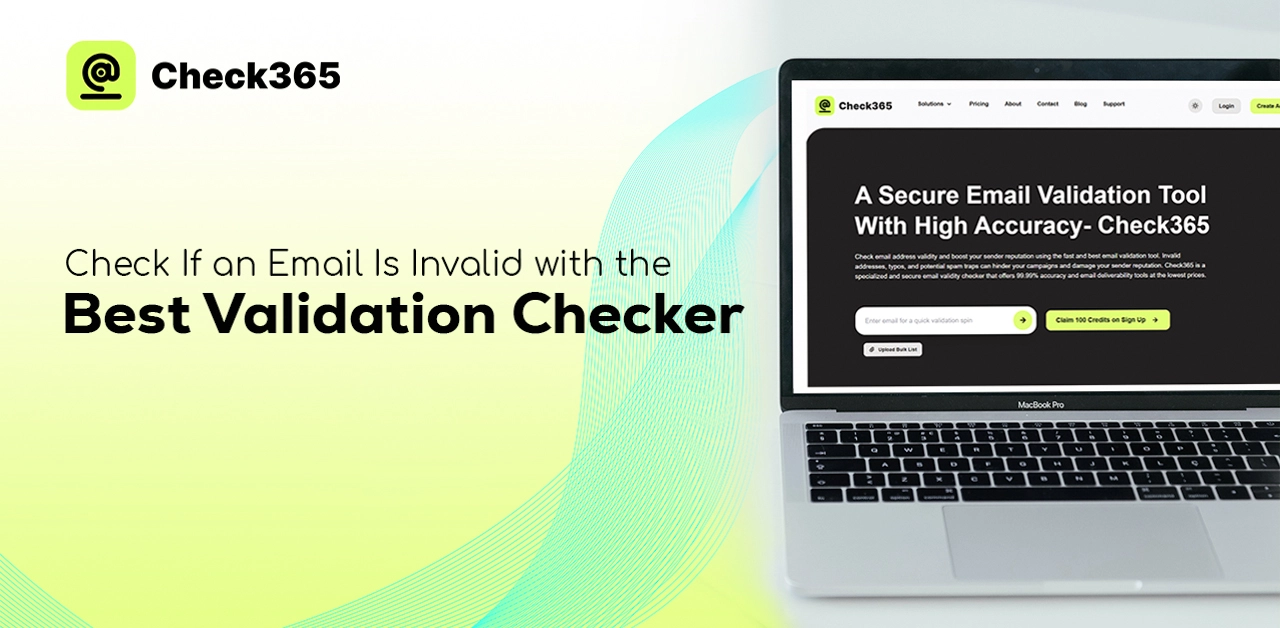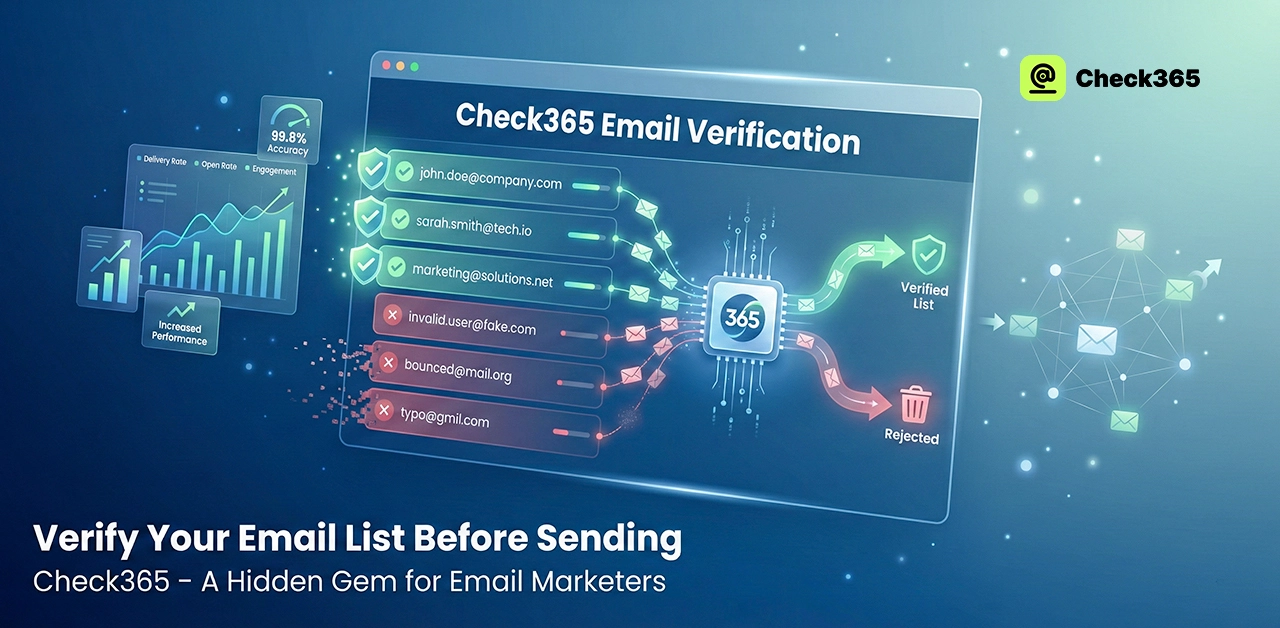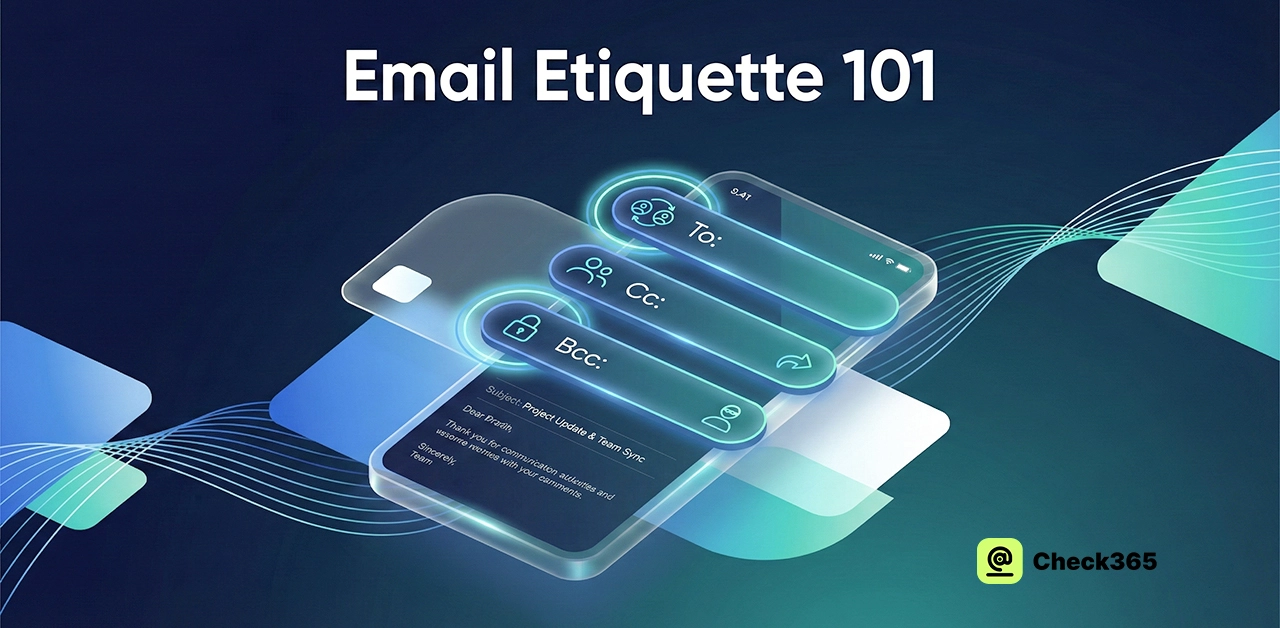Your email list is one of your best tools these days. If it's full of fake, inactive, or wrong addresses, though, it might do more harm than good. When you send bad emails, they get hard bounced, which hurts your image as a sender and makes your campaign less effective. Make sure that every email you send is real, alive, and safe before you send it. In this article, you will learn how to spot fake emails, why it's important, and how Check365 makes the whole process quick, accurate, and stress-free.
Check If an Email Is Invalid with the Best Validation Checker
Email names that don't work can really mess things up. They mess up your efforts, make more emails bounce, and hurt your image as a sender. That's why you should always read every email before you send something. The fastest and safest method? Check 365 is a good tool to use. If an address is fake, incorrect, or dangerous, it will be found quickly. It makes sure the mailbox exists, checks the format, and makes sure the name is live. It also finds throwaway emails, which are short-lived ones that people or bots use to avoid being called.
To check, all you have to do is type the email in. Check 365 lets you know right away if it's good or not. No email is sent, and everything runs in the background without making a sound. It can be used when people sign up, when they check out, or when they clean up their email list. You can keep your list clean and avoid big problems by using a tool like Check 365. It lowers the number of bounces, avoids spam traps, and keeps your name from getting marked.
How Can You Verify If a Website's Email Validation Is Functioning Properly?
If your system isn't working right, you might get bad data, more bounces, and a bad name as a provider. Here are some ways to check:
1. Enter Obvious Mistakes
Start with easy things. Try typing in emails that are obviously wrong, like test@, test@.com, @example.com, or test@example. It's a bad sign if your form lets any of these through. They should be blocked by a good email checker that shows an error message that tells you what went wrong. Not only does this help people fix their work, but it also keeps your database clean and organized.
2. Try Disposable Email Addresses
Get a short-term address at sites like Mailinator, Guerrilla Mail, or 10MinuteMail. You could use it on your sign-up form. There may be fake or low-quality people getting through if it gets through with no warning. By blocking throwaway emails, you can get more users and stop bots in their tracks.
3. Use a Made-Up Domain
Try going to user@fake-domain123.com as an email address. A good checker will check to see if the name already exists and turn it down if it doesn't. But tools like Check 365 do more than that. They check the domain's DNS records to make sure it can really receive emails. That's a lot more than just making sure the structure is correct.
4. Turn Off JavaScript
Front-end checking is helpful for people, but it's not enough to keep things safe. Close your browser's JavaScript window and type in a bad email address. It's possible that your confirmation is only on the front end if the form still sends. That's easy for bots to get around. Checks should also be done on the server side to catch anything that gets missed.
5. Use Check 365 for Deeper Testing
Want to be sure that your proof works? Check 365 is a good tool to use. It checks the MX records, the email address, and the mailbox to see if it's live. Use a real email address with a fake name, like fakeuser@example.com. If it still works on your machine, you may need to update your validation.
How to Validate If an Email Address Is Valid Before Registering the User?
Checking an email address before someone signs up can help you out a lot later on. Filtering out fake accounts, spam, and future shipping problems is made easier. Make sure the email is written correctly by typing it like this: name@example.com. After that, use an email verification tool like Check 365. In addition to style, these tools do other things.
Additionally, they confirm that the domain name is real and that the mailbox is active and ready to receive emails. Others can even find temporary or disposable addresses that people use to get around the rules. For an extra level of security, you can add real-time proof when people sign up. Email the person a proof link or code. The address is valid and working if they reply. Put simply, using style checks, validation tools, and email confirmation together helps keep your platform clean and organized. By blocking fake users, you'll lower your bounce rates and build a more involved, reliable audience.
How to Check Archived Emails in Gmail?
In Gmail, go to your mailbox and look at the menu on the left to find emails that have been saved. Pick "All Mail" from the "More" menu. This part shows everything, even texts that have been saved. You'll need to scroll or use the search bar to find them, as Gmail doesn't mark them as "Archived." If you want to find something, just type in a word or the sender's name. You can't see archived emails in your inbox, but they're still there until you delete them.
How to Check Email IP Address?
Click the three dots in the upper right corner of the message in Gmail, then select "Show original." A new tab will open with the body of the email. Find the line that starts "Received: from." Most of the time, the IP address is next to it. Check if any emails seem suspicious or determine their origin with this tool.
What Is Spam? - Is Spam an Acronym?
Spam is unwanted email, like ads, scams, or links to sketchy sites. It's sent all at once, which makes your email full. "Spam" is not a term, even though some people think it is. The name originates from a Monty Python sketch, in which the word "spam" was repeated over and over again. That joke turned into a great way to talk about messages that keep coming back. Most spam emails are now caught by blockers before they get to your inbox. Learn more about what spam is.
How to Test an Email Address Without Sending?
To verify if an email address is valid, you don't need to send a test email. You can test it without sending anything with tools like Check 365. These tools connect to the email server and verify if the address is valid and functioning. It's an easy way to keep your image good, clean up your list, and stop bounces. There is no guessing and no chance of ending up in the spam box.
Why Check 365 Is Your Best Friend for Email Validation?
Check 365 does more than just read your emails; it also helps you keep your whole email approach safe. It lets you know if an email is real, out there, and safe to use. With no returns and real names, you'll have a better sender score. It helps you create clean lists and send more effective messages because it provides results in real-time and is highly accurate.
Final Verdict
Email addresses that don't work do more damage than you might think. The time they take up is not worth it; they hurt your sender's reputation, and your campaign results go down. This is why it's so helpful to use a smart tool. You can block spam traps, fake emails, and risky addresses that cause bounces with Check 365. When you add a contact form, grow your email list, or clean up your CRM, it's important to make sure that your data is correct. You can check your email quickly with this tool. It works quickly, correctly, and lets you get in touch with real people, not bots or spam addresses.




